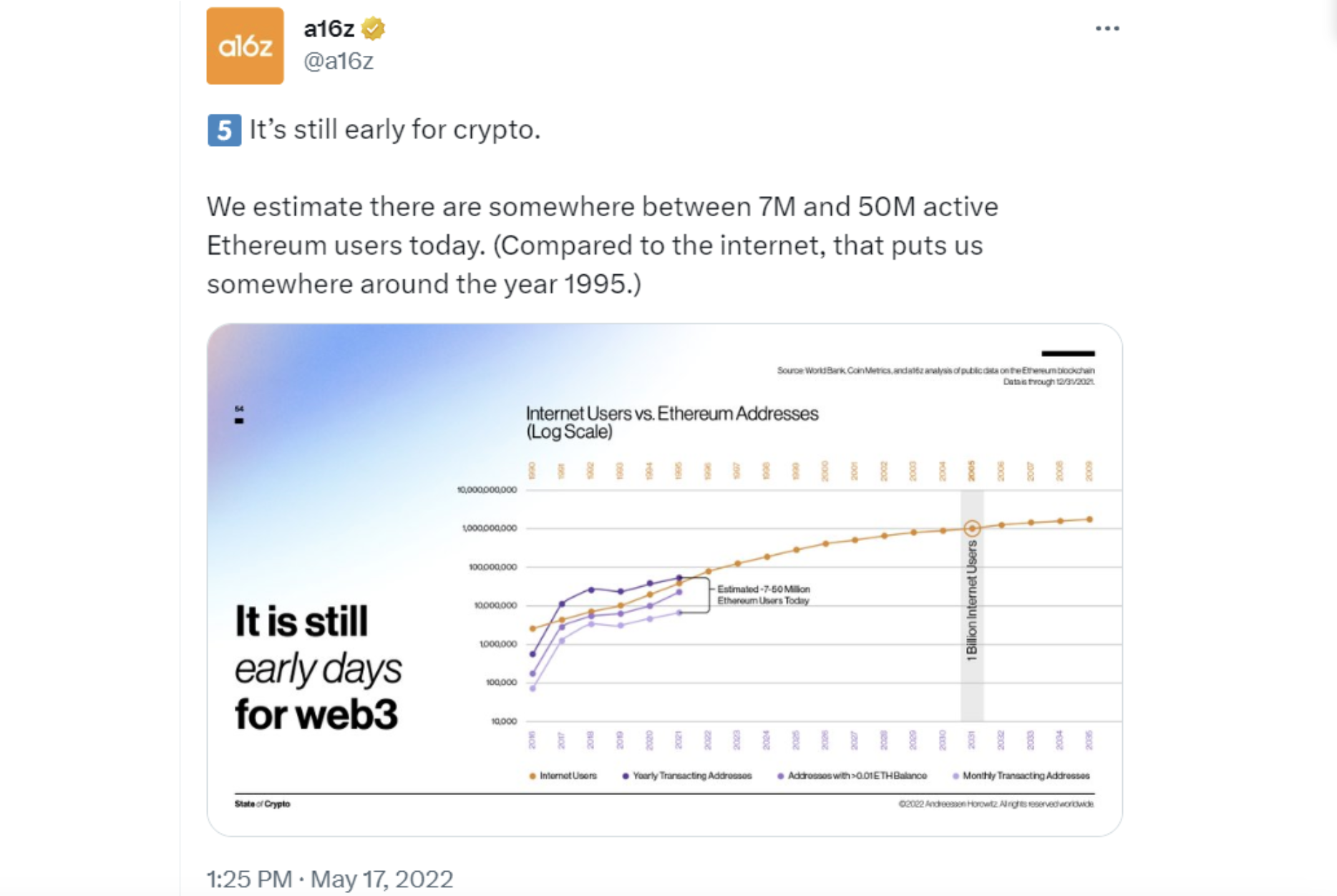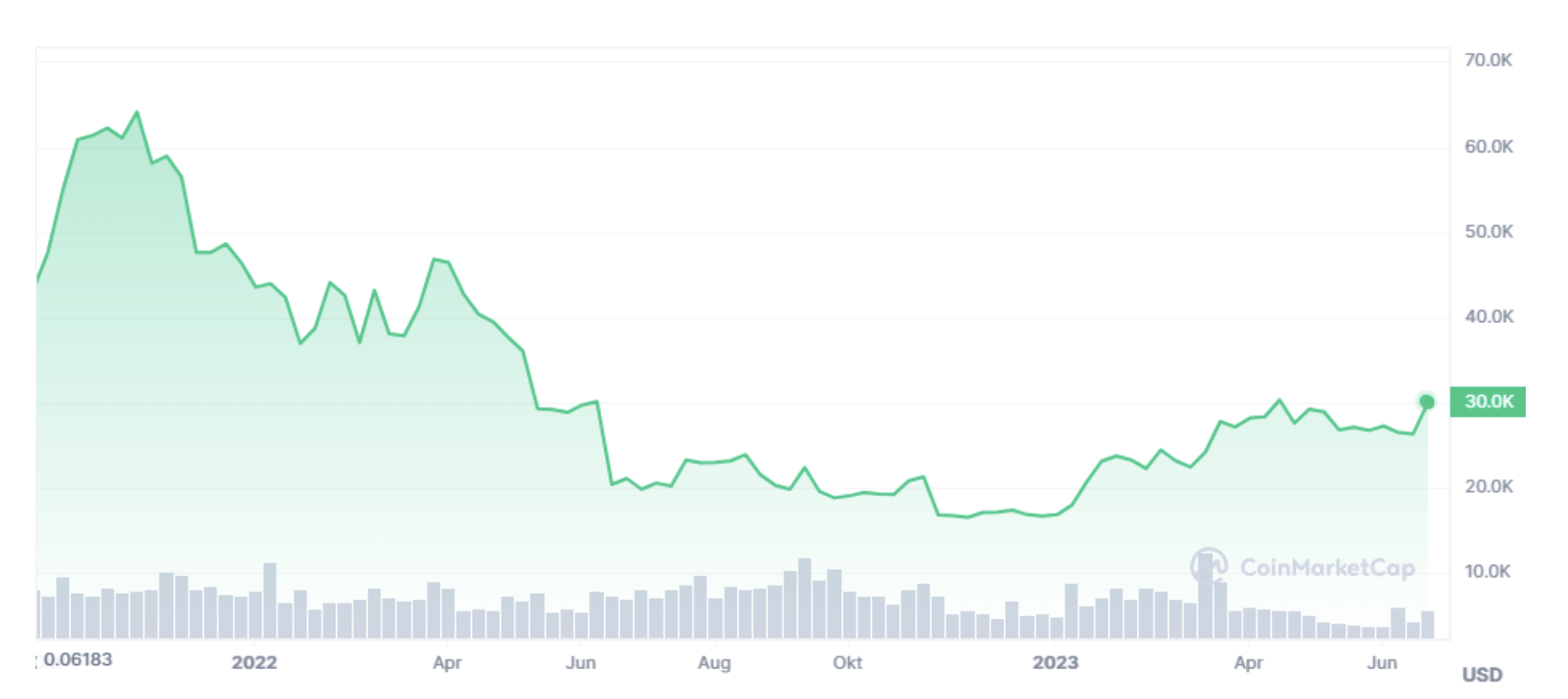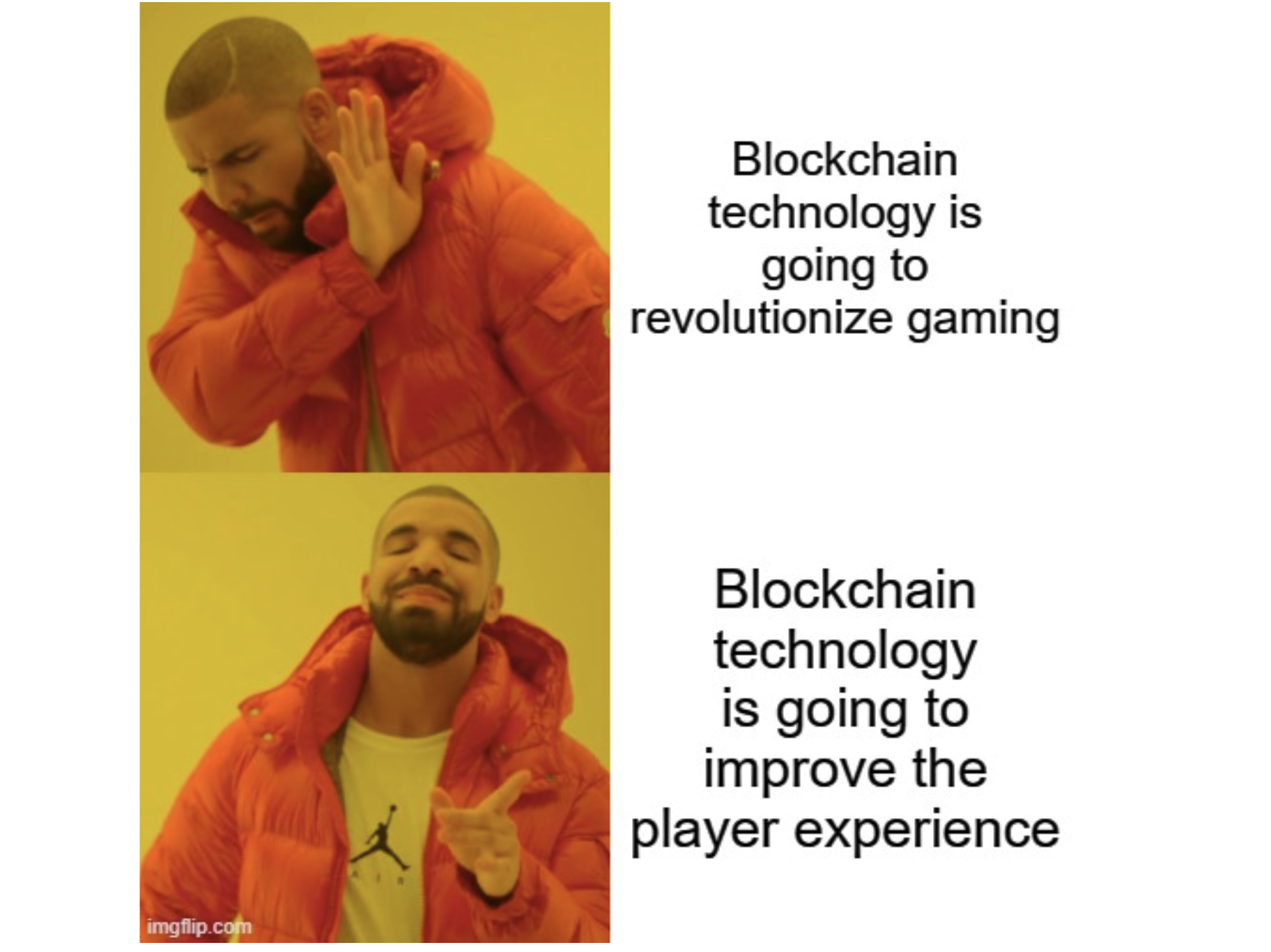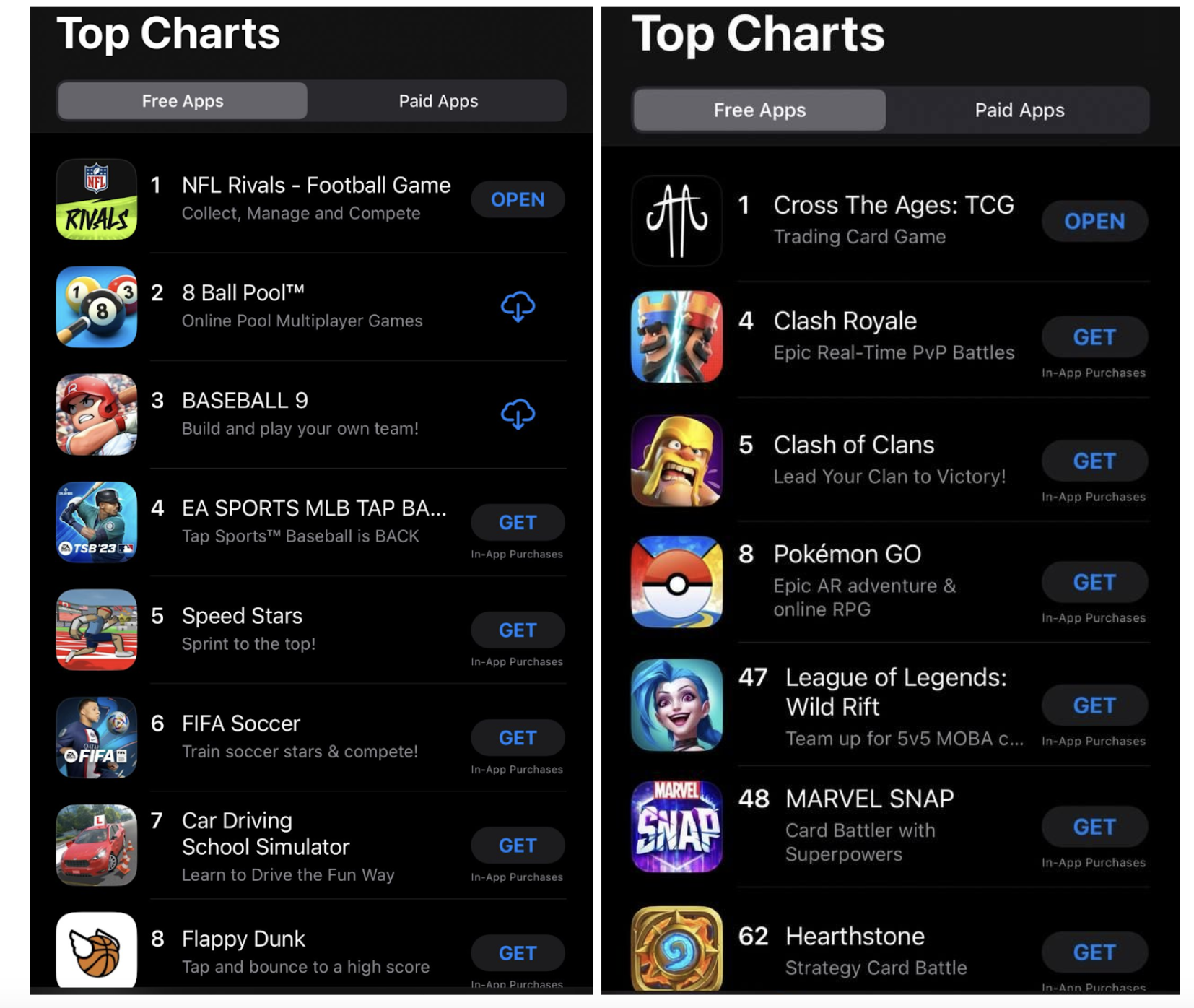Reflecting Upon the Last year in Blockchain Games
If you have been following the DoF newsletter and blog for the last year, you might have seen some of my articles on blockchain games, including a prediction piece. Although I had been watching the space for about a year by then, my interest in blockchain games peaked in the beginning of 2022 right after the latest (doubtfully the last) crypto bull run like most people. I was fascinated by the potential for innovation, which drew me into a rabbit hole that I am still partially engaged in.
Of course, when you start at such a high point, the most likely direction is downward. And things went down hard. It was so chaotic that people had to name crypto crashes by the leading factor like “the Luna crash” or “the FTX crash”. And when you work in such a tumultuous environment, it can be challenging to pause and reflect on the past events and their outcomes with the benefit of hindsight. So, let’s take a trip down memory lane…
“We are still early”
I’m sure everyone, myself included, is sick of the phrase above. However, it still holds true after all that we’ve been through. Blockchain games are still early.
First of all, it is almost impossible to find a best practice that is used by most, if not all, teams. Should you have tokens or only NFTs in your game? Should you immediately start working with a marketplace or do your own marketing? Can/Should you work with multiple marketplaces? What about the App Store and Play Store? Although some of these questions have favorable answers such as tokens being very discouraged, none of them has clear answers.
a16z saying “It’s still early for crypto” in 2022. They were saying the same in 2018. Wonder if they will say the same in 2026…
On one hand, this creates a very experimental environment with a large space for innovation. The rules of the game are not established yet, and, as a game developer, you are expected to create them. On the other hand, it leads to a quite unstable business where you might have to pivot after a year of development. Nobody was even discussing the necessity of tokens when crypto currencies were at their all time high. Every team was doing token sales whether it made sense or not. There is no guarantee that another bull cycle won’t create a similar situation.
What I’ve seen to be effective in this early stage is quite familiar to any game developer: being open to experimentation.
However, the hard part lies in experimenting with everything except the game development itself. You need to try different tactics while marketing your game or creating your community. You better talk to several different marketplaces and try out at least a few of them before committing to something long term. It’s like finding your way in the dark. So, the more you try, the more you will fail, and the more you will learn what to do.
Bitcoin for scale
It might be hard to accept that you need to keep track of the bull and bear cycles while working on your game. Because if you’re a game developer, you only care about the things that affect your game. It’s not limited to the gameplay itself. Thinking about Apple’s privacy changes or even the global recession makes sense since they directly affect your business. If you’re a blockchain game developer, on the other hand, you have to consider all of those things and one more external factor: the Bitcoin price.
Do you want to learn about how blockchain games are doing at a glance? Just look at the Bitcoin price graph.
You don’t have to use Bitcoin or any kind of crypto currency at all in your game. For every blockchain game, the performance of the crypto market is a very strong indicator of how they have been doing lately. Even if you have a killer game, when the market is crashing, you cannot market your game successfully since most of your potential players/investors are trying to survive. And Bitcoin price is a simple and effective benchmark for seeing how the market is doing. It doesn’t reflect the effects of game-specific incidents like the Axie Infinity bridge hack, but it still is a very efficient tool for getting a good understanding of the whole market. There is also the fact that most of the big crypto investors who got rich through crypto hold most of their balance in Bitcoin. So, it also shows how much the investors are gaining or losing at any given moment.
Although there is not much to do since it is completely out of your control, you can at least control how you react to it. You need to accept that most of your community will have a pessimistic outlook about most things when the market is down. This applies to your investors as well, which means you need to time your updates and investor meetings accordingly. For example, it’s reasonable to postpone all your meetings with potential investors during a crypto crash happening. They will have so many things on their minds that your game will be the least of their worries. A great game that was pitched or presented during a crypto crash is not going to get much positive reaction.
A business characterized by greed
When crypto investors such as NFT traders are among your most important stakeholders, their actions and demands play a huge role on how your business is shaped. As a blockchain game, you will sell NFTs on a marketplace and encourage your community to trade them between each other as they see fit. Usually, one would expect this activity to be based on the quality of the game. However, when you sell NFTs and create this secondary market, you invite crypto traders to enter your community. And for a crypto trader, making money is more important than being part of a community, to the extent that the game itself doesn't matter. It is just another project they are looking at.
Having crypto traders in your community doesn’t have to disrupt your game development process. On the other hand, your game development process will be shaped by decisions made by your partners, such as the marketplaces where you operate. And those marketplaces have to prioritize crypto traders to have volume. The demands of traders were so prioritized that NFT marketplaces had to play by their rules, removing royalties that incentivized wash trading. Without those royalties, people were able to trade NFTs of a specific collection between each other to increase its popularity, thus creating demand. Then they could sell those NFTs with a much higher price compared to its starting point and move on to the next project. You can check out one of our past newsletter articles (read: A race to the bottom on creator royalties?) discussing it in more detail.
There is a huge value misalignment within the blockchain games industry. When day traders, who only care about their daily financial gains, are given more importance than game developers and players, it becomes challenging to view things in a positive light from the developers’ perspective. Because the short term gains of a day trader often conflict with the long term sustainability a game developer desires. Of course, the issue of creator royalties is just one item in the backlog of things that a blockchain game needs to address and resolve. Nevertheless, the way it has been handled so far clearly proves the current priorities have to change.
I think blockchain game developers should be more proactive about these issues. Managing value misalignment is crucial and can only be achieved through collaborative work between developers and their partners. For example, it was hard to see blockchain game developers openly discussing the issue of creator royalties to voice their concerns. Some developers may have privately addressed the issue with marketplaces, but it appeared that the matter was primarily confined to the marketplaces and traders, with limited involvement of the developers themselves. Of course, those developers have a ton of things they have to figure out, but that’s what you sign up for when you enter such a new business! If this is left solely in the hands of stakeholders who are not involved in game development, I doubt the outcomes will prioritize the games themselves…
Letting the experts steer the ship
While the immediate priorities of the blockchain games industry may raise concerns and require transformation, the long-term plans hold the promise of a much brighter future. In the past 1.5-2 years, there has been a significant influx of talent transitioning to start or enhance blockchain game projects. It is not just at the executive level where a handful of famous names are transferred. Seasoned executives, developers, designers, and many more made the move to blockchain games. Although most of them come from the F2P mobile sector, the industry has observed professionals transitioning from the PC/console space to focus on developing AAA-quality blockchain games.
I think this is a very crucial step for the blockchain games business. The know-how and professional networks of individuals transitioning from the broader games industry will have a substantial impact on expanding the reach of blockchain games to a wider audience. It is not just that they know how to develop and operate games. Some of those individuals making the transition witnessed the birth of F2P and how it evolved in the last 15-20 years. Blockchain games require a similar, albeit smaller, transformation to become more accessible and sustainable for a significantly larger player base. With the help of this experience in transforming an industry, people will come to recognize that blockchain games are not mere ponzi schemes or pet projects, but rather a legitimate and viable business model upon which games can be built.
One thing that can be done more frequently with respect to utilizing know-how and skills of others is transferring existing teams. Acquiring existing developers is a good example of this practice which we will talk about in more detail later. These changes start with bringing individuals who are then able to bring others along with them, but it takes a village to make a game. And the fastest way to build that village is to transfer them all at the same time instead of picking them one by one.
Blockchain as a means to an end, not the end itself
In order to demonstrate the viability and success of blockchain games, game developers should come to terms with a harsh reality: The blockchain technology is just a tool to provide a richer experience for players, not the end goal itself. This is a pill hard to swallow since you have to accept that blockchain games are not going to start the new F2P movement changing the gaming landscape. All it can and should do is improve the current conditions under which games operate.
At the end of the day, our goal as game developers is a happy and engaged player base, right?
How the blockchain technology can be used as a tool to improve the player experience is the real question here. Although there are several answers, here are a few that I think will be useful going forward:
Higher player agency: With the help of the blockchain technology, players can have more agency in terms of ownership. It is not just the ownership of an asset in the shape of an NFT, but the ownership of the game itself. Games typically go through multiple testing phases, where a limited number of players are invited to play the game and provide feedback. Rewarding those players with a participation NFT, for example, will make them feel closer to the game. Imagine joining the early beta tests of a game and being able to show off with your participation NFT once the game is launched and becomes popular.
Increased conversion rate: One of the surest ways to generate more revenue from your game is to increase the conversion rate. When your game has a secondary market for players to trade NFTs between each other, it can act as a lower entry point to purchase an item. The rationale behind this is that the game will consistently introduce new items for purchase, such as new heroes or skins, which reduces the value of older items over time. While your biggest spenders, known as "whales," are typically eager to purchase new items as soon as they are released, the majority of your players may not share the same appetite for frequent and expensive purchases. Your secondary market powered by the blockchain technology enters the scene at that point, letting your whales sell their old items to other players. Those players making a purchase from the secondary market have just converted which is seen as the hardest part: making the player take the first step. Now you have a larger number of players who already made a purchase for your game that can be incentivized to do even more!
Improved UGC integration: There is no denying that User Generated Content is becoming more and more important each day. While most games don’t have a really structured way of having UGC, Fortnite announced they will share revenue with creators! So, it’s very likely that other games will follow suit. The blockchain technology can make this quite simple and intuitive. For example, if your game has user generated items that can be equipped, you can offer them as NFTs in addition to the rest of your collection. Then you can easily make the arrangements for sharing the revenues of the user generated NFTs between the game and the creator. This way, people would be incentivized to contribute to your game’s content while improving the overall gameplay experience.
Of course, these are just some examples that can be experimented with. I’m sure we will see much more interesting use cases as teams continue working on their games and figure out how to best integrate the blockchain technology.
A space where first movers are the slowest
Integrating blockchain technology in the right way was not top of mind when blockchain games were enjoying the bull run by the early entrants of the space. They were focused on blockchain technology more than the games themselves which created a bubble of projects (it is hard to call them games) that was waiting to burst. Of course, the burst happened after a short time and those early entrants realized they didn’t have the best approach to developing a game.
Thus far is not really surprising. If you value short term gains without caring about how to sustain your game and community in the long run, you are bound to fail. The shocking reality about those early entrants is how slow they have been despite the amount of investment they received from both VCs and individual investors. Any game that existed during the bull run at the end of 2021 is at least 1.5 years old now, but it’s incredibly hard to find any good game that started before or around that time. You can certainly find games that have potential and are enjoyed by their community among that cohort, but they are quite rare.
I think it shows how hard it is to make games and how important your intentions are. Most of those early entrants, sometimes called “the first wave of blockchain games”, were there for the money. They didn’t care if what they were building made sense as long as they were able to grab people’s money and attention. And I’m not talking about the obvious pump & dump schemes exploiting people’s inexperience or the rug pull projects literally scamming people. Even most of the teams that raised a ton of VC money haven’t still come up with a simple playable, let alone a proper game. The late entrants, on the other hand, display a clear discipline on how they build their games and community while also showing significant signs of improvement consistently. If anyone from those early entrants or first wave games are reading this, please take note of your successors since they clearly surpassed you…
Consolidation is real
One thing those early entrants have is a ton of money sitting in their bank accounts and wallets. And one effective way to use that is to acquire other players who have demonstrated both past success and potential for a promising future. That is exactly what they have been doing, and it is not just blockchain games companies acquiring other blockchain games companies. For example, Gala Games acquired Ember Entertainment at the beginning of 2023 in order to bring Ember’s portfolio onto their platform.
Another way of consolidating power has been through strategic partnerships. It is uncommon for the biggest names in a market to join forces since everyone wants to maximize their own share. However, during the bear market, in addition to the concerns of a global recession, even the largest blockchain companies had to collaborate with their competitors to ensure their survival. Given the situation is not expected to improve anytime soon, it is likely that the method of consolidating powers through partnerships will continue in the coming months.
If you want to get a more detailed analysis on how the blockchain games companies are consolidating, you can check out Web3 Gaming Consolidates to Survive.
Building upon the previous point regarding talent transfer, it is highly likely that consolidation will continue to increase in the near future. Money is more expensive than it was a couple of years ago, and the crypto market is not being helpful at all. Still, there are big enough teams and VCs out there executing and facilitating the blockchain consolidation. With the right mixture of experience and talent, we should see much better games produced in a much shorter time.
Trying to reach billions
Consolidation has not only occurred at the company level but has also impacted the platforms where blockchain games operate. At the beginning of 2022, the hopes and dreams of most blockchain game developers were a world free of dominant platforms like Apple or Steam. They envisioned a decentralized world where anonymous community members could influence the development of their favorite games. Of course, this dream turned out to be somewhat naive and lacked a solid foundation.
Having the proper means of distribution is crucial for the success of your game. Developing a great game does not make the cut. You need to find a large audience that is interested in playing your game and eventually willing to pay for it.
Traditionally, game developers have relied on platforms like Steam and Epic for PC/console games, while the App Store and Play Store have been the dominant platforms for mobile games. After it became apparent that Steam had restrictions on hosting blockchain games, many developers turned to Epic as the preferred platform for PC games in the blockchain space. Regarding the App Store and Play Store, we only have the guideline updates from Apple, which do not provide a clear indication of how they will handle blockchain games.
Epic Games Store has been pretty active and it seems like they have listed 18 blockchain games so far. And the list gets more and more crowded continuously! Blankos Block Party from Mythical Games was the first one back in September 2022 while Gods Unchained from Immutable is the latest entry. I’m sure they are talking to dozens of other games each week and they might even end up with an exclusive section for blockchain games in the future!
NFL Rivals and Cross The Ages are two successful examples of blockchain games released on the App Store.
On the mobile side, the App Store has been used quite aggressively by teams to release a lightweight version of their game without any blockchain related feature. It looks like blockchain game developers prefer mass market reach over decentralization just as we predicted! Since the guideline updates didn't provide clear guidance, this approach of experimentation serves as a starting point to assess how the situation will unfold and evolve over time. I’m sure we will see news about blockchain games being rejected by the App Store because they pushed the boundaries too far with their blockchain integration.
So what?
At the end of the day, it is safe to say that blockchain games will keep coming. Teams are gaining insights from their own and others' mistakes, and with the addition of experienced individuals, they are translating these lessons into practical steps.
I think there is still a long way until a significant portion of the market uses the blockchain technology, but how the whole space evolved in the last couple of years is no small feat! Teams quickly moving away from buzzwords like decentralization and using the broader gaming industry for distribution like the App Store or Play Store is one example. Also, the F2O (Free to Own) movement and the practice of handing out free NFTs for early supporters can be shown as another positive change. Creating a no investment-low risk environment seems to have worked for having more game focused communities.
So, if teams:
Continue experimenting
Collaborate with other stakeholders more
Benefit from the existing know-how and gaming practices
Use the blockchain technology not as a target but as a tool
they will gradually gain momentum and evolve into significant strides, ultimately accelerating progress in various aspects.
Written by Ahmetcan Demirel







